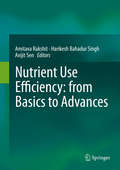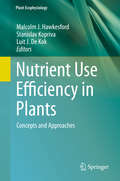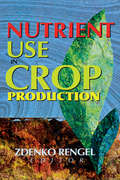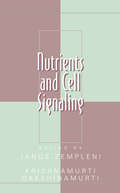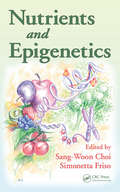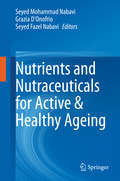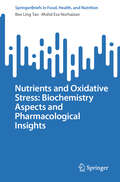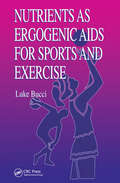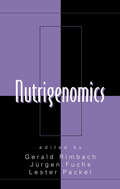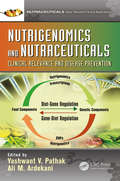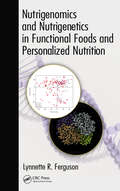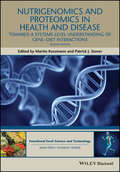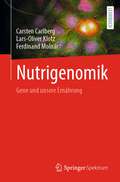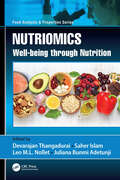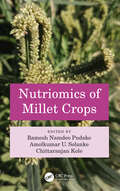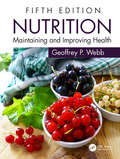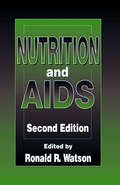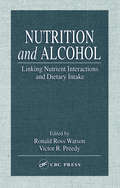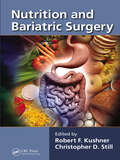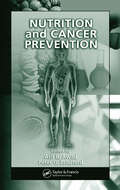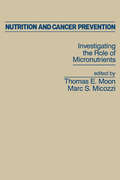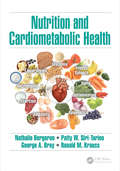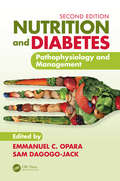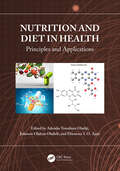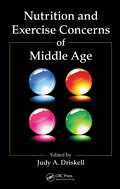- Table View
- List View
Nutrient Use Efficiency: from Basics to Advances
by Avijit Sen Harikesh Bahadur Singh Amitava RakshitThis book addresses in detail multifaceted approaches to boosting nutrient use efficiency (NUE) that are modified by plant interactions with environmental variables and combine physiological, microbial, biotechnological and agronomic aspects. Conveying an in-depth understanding of the topic will spark the development of new cultivars and strains to induce NUE, coupled with best management practices that will immensely benefit agricultural systems, safeguarding their soil, water, and air quality. Written by recognized experts in the field, the book is intended to provide students, scientists and policymakers with essential insights into holistic approaches to NUE, as well as an overview of some successful case studies. In the present understanding of agriculture, NUE represents a question of process optimization in response to the increasing fragility of our natural resources base and threats to food grain security across the globe. Further improving nutrient use efficiency is a prerequisite to reducing production costs, expanding crop acreage into non-competitive marginal lands with low nutrient resources, and preventing environmental contamination. The nutrients most commonly limiting plant growth are N, P, K, S and micronutrients like Fe, Zn, B and Mo. NUE depends on the ability to efficiently take up the nutrient from the soil, but also on transport, storage, mobilization, usage within the plant and the environment. A number of approaches can help us to understand NUE as a whole. One involves adopting best crop management practices that take into account root-induced rhizosphere processes, which play a pivotal role in controlling nutrient dynamics in the soil-plant-atmosphere continuum. New technologies, from basic tools like leaf color charts to sophisticated sensor-based systems and laser land leveling, can reduce the dependency on laboratory assistance and manual labor. Another approach concerns the development of crop plants through genetic manipulations that allow them to take up and assimilate nutrients more efficiently, as well as identifying processes of plant responses to nutrient deficiency stress and exploring natural genetic variation. Though only recently introduced, the ability of microbial inoculants to induce NUE is gaining in importance, as the loss, immobilization, release and availability of nutrients are mediated by soil microbial processes.
Nutrient Use Efficiency in Plants
by Malcolm J. Hawkesford Stanislav Kopriva Luit J. De KokNutrient Use Efficiency in Plants: Concepts and Approaches is the ninth volume in the Plant Ecophysiology series. It presents a broad overview of topics related to improvement of nutrient use efficiency of crops. Nutrient use efficiency (NUE) is a measure of how well plants use the available mineral nutrients. It can be defined as yield (biomass) per unit input (fertilizer, nutrient content). NUE is a complex trait: it depends on the ability to take up the nutrients from the soil, but also on transport, storage, mobilization, usage within the plant, and even on the environment. NUE is of particular interest as a major target for crop improvement. Improvement of NUE is an essential pre-requisite for expansion of crop production into marginal lands with low nutrient availability but also a way to reduce use of inorganic fertilizer.
Nutrient Use in Crop Production
by Zdenko RengelIf you?re an agronomist, horticulturalist, plant and soil scientist, breeder, or soil microbiologist, you?ll want to read Nutrient Use in Crop Production to find everything you need to know about judicious nutrient management and maximizing nutrient utilization in the agricultural landscape. In this book, you?ll discover ways to minimize undesirable nutrient losses and techniques for preserving the environment while meeting the challenges of providing the earth?s increasing population with sufficient food, feed, and fiber to sustain life. Your existing knowledge base concerning this vital area of science will expand and grow as you become more open to the new ideas and applications contained in Nutrient Use in Crop Production. Most importantly, you?ll avoid the narrow scope found in most crop nutrition books and take a broader, more globally minded view of how to maximize nutrient use and minimize nutrient losses in the soil of agricultural systems. Specifically, you?ll find these and other areas covered:population growth, food production, and nutrient requirementsmanaging soil fertility declinethe role of nitrogen fixation in crop productiondelivering fertilizers through seed coatingsmicronutrient fertilizersthe role of nutrient-efficient crops in modern agricultureFeeding the world without depleting the world?s viable soil nutrients is a monumental task--but one that can be achieved, as evidenced in the pages of Nutrient Use in Crop Production. You and your circle of students, professionals, and administrators will benefit greatly from this in-depth view of nutrient use in both developed and non-industrialized counties to give you a better sense of how to allow both the world and the world?s crops to grow.
Nutrients and Cell Signaling
by Janos ZempleniCell signaling is at the core of most biological processes from the simplest to the most complex. In addition to unicellular organisms possessing the essential ability to receive inputs with regard to nutrient availability and noxious stimuli, the cells in multicellular organisms require signaling from adjacent, as well as distant cells to maintain
Nutrients and Epigenetics
by Sang-Woon Choi Simonetta FrisoExplores the Newly Discovered Link Between Nutrition and EpigeneticsCurrent research suggests that nutrients are more than just food components and that certain nutrients can impact the expression of genes that lead to the development of chronic diseases. With contributions from experts in both fields, Nutrients and Epigenetics examines the epigene
Nutrients and Nutraceuticals for Active & Healthy Ageing
by Seyed Mohammad Nabavi Grazia D’Onofrio Seyed Fazel NabaviThis book focuses on the nutrients and nutraceuticals that promote active and healthy ageing – recently defined by the WHO as the process of development and maintenance of functional capacity that allows well-being at an advanced stage of life. There has been a rapid rise in the use of nutritional interventions as well as specific nutraceuticals in the management of multifactorial aspects of clinical health outcomes. Written by leading experts this book comprehensively discusses the various ageing phenotypes and age-related diseases. It also assesses the nutritional status of the elderly and the various epidemiological factors that influence it. It reviews the role of dietary fiber in disease-free and fully functional ageing. Further, the book explores the benefits of polyphenols, which are secondary plant metabolites, in protecting against cancer, cardiovascular diseases, and various neurodegenerative diseases.
Nutrients and Oxidative Stress: Biochemistry Aspects and Pharmacological Insights (SpringerBriefs in Food, Health, and Nutrition)
by Bee Ling Tan Mohd Esa NorhaizanOxidative stress plays a prominent role in the development of numerous human diseases associated with animal-based protein, high-carbohydrate diets and excessive fat consumption. Obesity represents the main risk factor for chronic diseases such as cardiovascular disease, cancer, and type 2 diabetes. Extensive research highlights the detrimental impacts of diets high in saturated fat and refined carbohydrates. Type 2 diabetes, cardiovascular disease and obesity are attributed to the sedentary lifestyles, overconsumption of foods high in saturated fats and carbohydrates, and the saturation of nutrient storage. Indeed, the effects of oxidative stress are associated with the absolute quantity and the type of macronutrients; both of these aspects contribute to oxidative stress and may favor the development of obesity-associated diseases and obesity. Nonetheless, the underlying mechanisms of nutritionally mediated oxidative stress are complex and poorly understood. The literature reported on nutritionally mediated oxidative stress and the role of diets in oxidative stress-induced diseases has not well been compiled in a singular source. “Nutrients and Oxidative Stress: Biochemistry Aspects and Pharmacological Insights” explores how dietary choices dampen or exacerbate inflammation and oxidative stress. The implications of oxidative stress in glucose metabolism and adipocyte and obesity-associated non-communicable diseases are also discussed in this brief. Several issues linked to nutritionally mediated oxidative stress, including high carbohydrates, high animal-based proteins, and excessive consumption of fats and oxidative stress, and molecular mechanisms of oxidative stress-induced diseases are covered. The role of diets in oxidative stress-induced diseases is also discussed. By summarizing all the literature in one place, this work provides a cohesive representation of the information and practical reference on the underlying mechanisms of nutritionally mediated oxidative stress involved in the prevention of chronic diseases. The work provides a better understanding of the nutritionally mediated oxidative stress and the molecular mechanisms of oxidative stress in the development of chronic diseases and obesity.
Nutrients as Ergogenic Aids for Sports and Exercise (Nutrition In Exercise And Sport Ser. #2)
by Luke R. BucciNutrients as Ergogenic Aids for Sports and Exercise discusses the growing body of information regarding the enhancement of human physical performance by dietary manipulations through ergogenesis. It balances the application of nutritional manipulations between overzealous promoters and recalcitrant cynics. By offering a thorough, comprehensive and up-to-date review of what is known about ergogenic effects of nutrients on humans, it bridges the gap between common usage and scientific knowledge. Nutrients as Ergogenic Aids for Sports and Exercise covers in detail many popular product ingredients not considered elsewhere. It illustrates areas awaiting future research, and offers suggestions for avoiding the pitfalls of performing ergogenesis research.
Nutrigenomics (Oxidative Stress and Disease)
by Martin GardnerNutritional genomics, also referred to as nutrigenomics, is considered one of the next frontiers in the post-genomic era. This book features the latest research on the role of oxidants and dietary antioxidants in the modulation of gene expression, aging, immune function, neuroprotection, and vascular heath. It covers the relationship between oxidants, antioxidants, and gene expression, as well as new molecular techniques for the study of redox-regulated signal transduction. It summarizes the molecular mechanisms of phytochemicals and trace elements, emphasizes the impact of variations in the human genotype on individual responses to nutrients, and offers a summary of the effect of lipid and water soluble antioxidants and fatty acids on gene expression in cultured cells, laboratory animals, and humans.
Nutrigenomics and Nutraceuticals: Clinical Relevance and Disease Prevention (Nutraceuticals)
by Yashwant V. Pathak Ali M. ArdekaniGenomics and related areas of research have contributed greatly to the understanding of the cellular and molecular mechanisms underlying diet–disease relationships. In the past decade, the evidence has become stronger for a direct link between genome/epigenome damage and increased risk for adverse health outcomes. It is now exceedingly clear that micronutrients are critical as cofactors for many cellular functions, including DNA repair enzymes, methylation of CpG sequences, DNA oxidation, and/or uracil incorporation into DNA. Nutrigenomics and Nutraceuticals: Clinical Relevance and Disease Prevention brings new perspectives on disease prevention strategy based on the genomic knowledge and nutraceuticals of an individual and the diet he or she receives. This book discusses the integration and application of genetic and genomics technology into nutrition research and paves the way for the development of nutrition research programs that are aimed at the prevention and control of chronic disease through genomics-based nutritional interventions. In this book, the editors bring together a wide spectrum of nutritional scientists worldwide to contribute to the growing knowledge in the field of nutrigenomics and nutraceuticals.
Nutrigenomics and Nutrigenetics in Functional Foods and Personalized Nutrition
by Lynnette R. FergusonWhile functional foods have become a reasonably well-established concept, personalized nutrition is still treated with skepticism by many. The recognition that people would have different nutrient requirements, or perceive foods in different ways, raises several concerns-some real, some not so real. Nutrigenomics and Nutrigenetics in Functional Foo
Nutrigenomics and Proteomics in Health and Disease: Towards a systems-level understanding of gene-diet interactions
by Martin Kussmann Patrick J. StoverNow in a revised second edition, Nutrigenomics and Proteomics in Health and Disease brings together the very latest science based upon nutrigenomics and proteomics in food and health. Coverage includes many important nutraceuticals and their impact on gene interaction and health. Authored by an international team of multidisciplinary researchers, this book acquaints food and nutrition professionals with these new fields of nutrition research and conveys the state of the science to date. Thoroughly updated to reflect the most current developments in the field, the second edition includes six new chapters covering gut health and the personal microbiome; gut microbe-derived bioactive metabolites; proteomics and peptidomics in nutrition; gene selection for nutrigenomic studies; gene-nutrient network analysis, and nutrigenomics to nutritional systems biology. An additional five chapters have also been significantly remodelled. The new text includes a rethinking of in vitro and in vivo models with regard to their translatability into human phenotypes, and normative science methods and approaches have been complemented by more comprehensive systems biology-based investigations, deploying a multitude of omic platforms in an integrated fashion. Innovative tools and methods for statistical treatment and biological network analysis are also now included.
Nutrigenomik: Gene und unsere Ernährung
by Carsten Carlberg Lars-Oliver Klotz Ferdinand MolnárWarum verstoffwechseln wir dieselben Mahlzeiten so unterschiedlich? Haben ernährungsbedingte Erkrankungen eine genetische Ursache? Können Genuntersuchungen Vorhersagen zum Eintreten solcher Erkrankungen liefern? Welchen Einfluss haben Umwelt und Verhalten? Mit diesen und ähnlichen Fragen befasst sich das Gebiet der Nutrigenomik, das die Wechselwirkung zwischen Ernährung und Genom erforscht. Zu Beginn dieses Lehrbuchs wird ein Überblick über die Bedeutung der Nutrigenomik im Kontext der Ernährungswissenschaften gegeben. Sodann wird auf das menschliche Genom sowie seine Variationen eingegangen und der besondere Einfluss der Ernährung auf dessen Evolution beschrieben. Im Anschluss werden die molekularen Grundlagen der Wechselwirkung von Nährstoffen und anderen Nahrungsbestandteilen mit zellulären Signalnetzwerken besprochen, die die Genexpression modulieren. In drei abschließenden Kapiteln werden nutrigenomische Aspekte von Erkrankungen wie Adipositas, Diabetes und Herz-Kreislauf-Erkrankungen besprochen. Dieses Lehrbuch richtet sich an Studierende der Ernährungswissenschaften, der Biochemie und Molekularbiologie sowie der Biologie. Zahlreiche Farbabbildungen unterstützen die Wissensvermittlung, indem komplexe Abläufe grafisch zusammengefasst werden. Verbunden mit einem Glossar, das die wichtigsten Fachbegriffe erklärt, eignet sich das Werk somit ideal zur Modulbegleitung und Prüfungsvorbereitung.
Nutriomics: Well-being through Nutrition (ISSN)
by Devarajan Thangadurai Saher Islam Leo M.L. Nollet Juliana Bunmi AdetunjiImplementation of robust omics technologies enables integrative and holistic interrogation related to nutrition by labeling biomarkers to empirically assess the dietary intake. Nutriomics: Well-being through Nutrition aims to enhance scientific evidence based on omics technologies and effectiveness of nutrition guidelines to promote well-being. It provides deep understanding towards nutrients and genotype effects on disease and health status. It also unveils the nutrient–health relation at the population and individual scale. This book helps to design the precise nutritional recommendations for prevention or treatment of nutrition-related syndromes.Nutriomics: Well-being through Nutrition focuses on: The impact of molecular approaches to revolutionize nutrition research for human well-being Various biomarkers for bioactive ingredient analysis in nutritional intervention research Potential of transcriptomic, genomic, proteomic, metabolomic, and epigenomic tools for nutrition care practices Recent updates on applications of omics technologies towards personalized nutrition Providing comprehensive reviews about omics technologies in nutritional science, Nutriomics: Well-being through Nutrition serves as an advanced source of reference for food developers, nutritionists, and dietary researchers to investigate and evaluate nutriomics tools for development of customized nutrition and food safety. It is also a useful source for clinicians and food industry officials who require intense knowledge about emerging dietary-related tools to revolutionize the nutrition industry.This is a volume in the Food Analysis and Properties series, a series designed to provide state-of-art coverage on topics to the understanding of physical, chemical, and functional properties of foods.
Nutriomics of Millet Crops
by Ramesh Namdeo Pudake Amolkumar U. Solanke Chittaranjan KoleMillets are popularly known as “nutri-cereals” due to their high calcium, dietary fiber, polyphenol, vitamins, and protein content. Millet crops have the potential to aid in food security efforts in regions where natural and manmade causes are deteriorating land resources. Nutriomics of Millet Crops emphasizes the importance of nutriomics of millet crops in the context of universal health, highlighting biotechnological advancements offering enrichment of the nutritional value of millets. Millet crops have the potential to be a staple crop, demonstrating an economically feasible approach to combat micronutrient malnutrition. Features: Presents comprehensive studies on health-promoting nutritional components of millets. Provides enumeration on molecular breeding strategies for improvement of millet nutraceuticals. Discusses genomics-assisted breeding for enhancement of nutritional quality in millets. Includes information related to sensory and biofortification of millet-based foods. By assessing the relevance of millets in sustainable global agro-ecosystems due to their nutritional and agronomic attributes, the United Nations celebrated 2023 as the “International Year of Millets.” This book complements this effort and is useful to researchers and policy planners working across the disciplines of plant breeding and food technology. Nutriomics of Millet Crops also encourages young researchers to explore this promising field.
Nutrition: Maintaining and Improving Health (An\arnold Publication Ser.)
by Geoffrey P. WebbFollowing the tradition of its predecessor, the fifth edition of Nutrition: Maintaining and Improving Health continues to offer a wide-ranging coverage of all aspects of nutrition while providing new information to this edition including: Increased coverage of experimental and observational methods used in nutrition In-depth focus on the nutritional implications of the increased adoption of vegetarian and vegan lifestyles Streamlined referencing - a short selected list of key references at the end of each chapter with URL links to free additional resources where possible Discussion of nutrition debates Critical coverage of "medicinal uses of food" including superfoods, functional foods and dietary supplements Updated bullet point summaries of key points after each major topic within each chapter The author provides an evidence-based evaluation of many key nutrition beliefs and philosophies. The book contains in-depth and critical reviews of the methods used to evaluate nutritional intakes/status and the observational and experimental used to investigate putative links between dietary factors and health outcome. It covers the role of food as a source of energy and nutrients while discussing the non-nutritional roles of food and the social and psychological factors that influence food choice. Presenting a critical discussion on the value of nutrition research linking specific foods or nutrients to specific diseases which encourages students to question the value of some current nutrition research. This is essential reading for all nutrition and dietetics students with different backgrounds who are studying nutrition as a specific discipline for the first time.
Nutrition and AIDS (Modern Nutrition)
by Ronald R. WatsonEvidence shows that nutritional supports can help maintain health in the HIV-infected patient by replacing lost nutrients, compensating for nutritional damage done by the retrovirus-induced immunodeficiency, and stimulating the remaining immune system and cells for better host defenses.This new edition of Nutrition and AIDS is a timely look
Nutrition and Alcohol: Linking Nutrient Interactions and Dietary Intake
by Ronald Ross Watson Victor R. PreedyOver the past decade, much has been learned about the damaging effects that moderate to severe alcohol use has on tissue nutrient levels and dietary intake. In addition to alcohol's potential to damage every organ in the body, alcohol abuse or heavy use causes poorer dietary intake and provides a greater risk of alcohol's damage while increasing th
Nutrition and Bariatric Surgery
by Robert F. Kushner Christopher D. StillBariatric surgery has led to improved health outcomes including significant weight loss and reduction in co-morbidities among patients with obesity. Clinical practice guidelines recommend that patients considering bariatric surgery undergo a comprehensive nutritional assessment. Nutrition and Bariatric Surgery is the first comprehensive book that u
Nutrition and Cancer Prevention
by Atif B. Awad Peter G. Bradford� Epidemiological studies have estimated that approximately 35 percent of cancers are potentially avoidable by nutritional modification. These modifications include strategies such as caloric restriction and limitation of specific macro-nutrient groups. However, recent research indicates that what you eat may well be just as important as what you s
Nutrition and Cancer Prevention
by Thomas E. Moon; Marc S. MicozziScientific advances have led to the recognition that many chronic diseases such as cancer may be preventable. In this volume, 36 contributions test cancer prevention hypotheses, attempt to interpret their results, and provide a guide to the background, rationale, and selection of cancer prevention agents, as well as the design, im>plementation, and evaluation of cancer prevention studies. It will offer assistance to many in the conduct of investigations and will be of interest to all in the in>terpretation of research results in the scientific literature.
Nutrition and Cardiometabolic Health
by Nathalie Bergeron Patty W. Siri-Tarino George A. Bray Ronald M. KraussNutrition plays a key role in prevention of cardiovascular disease, the leading cause of death worldwide. Diet influences a broad spectrum of cardiometabolic risk factors, notably a cluster including excess adiposity, dyslipidemia, impaired glucose metabolism and high blood pressure. In the face of the rapidly increasing incidence of obesity and diabetes, maintaining cardiometabolic health through adoption of a healthy lifestyle is a top public health priority. <P><P>In this book, Nutrition and Cardiometabolic Health, international experts present state-of-the-art scholarly reviews of dietary and lifestyle effects on metabolic systems associated with cardiovascular health and disease. It covers a broad range of topics including biological and behavioral processes regulating food intake; lifestyle and surgical approaches to weight loss; nutritional considerations for optimal cardiometabolic health across the lifespan; the relationship of macronutrients, whole foods and dietary patterns to diabetes and cardiovascular disease; and diet as a modulator of gene expression, epigenetics and the gut microbiome and the relationship of these traits to disorders of metabolism. This book provides its readers with an authoritative view of the present state of knowledge of dietary effects on cardiometabolic health and will be of interest to nutrition and healthcare professionals alike.
Nutrition and Diabetes: Pathophysiology and Management
by Emmanuel C. Opara and Sam Dagogo-JackDiabetes occurs at such an alarming rate that it can be described as a global epidemic. Following its predecessor, Nutrition and Diabetes: Pathophysiology and Management, Second Edition, is a comprehensive resource that describes various factors that drive the accumulation of excess body weight and fat resulting in obesity. The book discusses the metabolic aberrations found in obesity and how they lead to the association of obesity with diabetes. This new edition highlights the role played by diet and the interrelationships in the metabolism of key nutrients in the pathogenesis of obesity and diabetes which provides the scientific basis for treatment and management approaches.Features Highlights the role of nutrition in the pathogenesis of obesity and diabetes Organized logically into two easy-to-use sections - Pathophysiology and Management of Obesity and Pathophysiology and Treatment of Diabetes Features emerging therapeutic approaches for management of obesity and diabetes Discusses experience in the management of obesity and diabetes in developing countries Presents challenges in insulin therapy and provides guidelines to overcome them The first section of the book retains key topics from the previous edition and contains new chapters including genetic determinants of nutrient processing; fat distribution and diabetes mellitus; combined effect of diet and physical activity in the management of obesity; pharmacologic treatment of obesity; and the role of gut microbiota in the pathogenesis and treatment of obesity. The second section features updated versions of most of the other chapters in the first edition comprising a modified chapter on oxidative stress and the effects of dietary supplements on glycemic control in Type 2 diabetes. In addition, new chapters are added in this section and include the contribution of iron and transition metal micronutrients to diabetes; role of microbiota in the pathogenesis and treatment of diabetes; primary prevention of Type 2 diabetes; and the pathophysiology and management of Type 1 diabetes.
Nutrition and Diet in Health: Principles and Applications
by Adenike Temidayo Oladiji Johnson Olaleye Oladele Ebenezer I. O. AjayiNutrition and diet play a crucial role in sustaining good health throughout human lives. Food provides us with essential nutrients involved in many physiological activities and biological processes in the body including growth and development, metabolism, immune function, and overall well-being. Nutrition and Diet in Health: Principles and Applications reviews and discusses the issues related to the roles of nutrition and diet in human health and diseases.The book contains two sections – one section features principles, the other, covers applications. Part I provides information on sustainable use of nutrition and diets in health and diseases; advanced biotechnological approaches to improve nutritional content of food; trace elements in nutrition; drug and nutrient interactions; functional foods and nutraceuticals in health maintenance; and biomarkers of functional foods and nutraceuticals in health maintenance. Part II discusses the significance of nutrition in selected human diseases, including cardiovascular diseases, cancer, infection, neurodegenerative diseases, and metabolic co-morbidities. It also discusses optimal nutrition for wellness, fitness, pregnancy, mental health, aging, and longevity.Features Molecular and cellular-based research findings on the principles and applications of nutrition and diet in health Roles of nutritional agents in the pathogenesis of human diseases Underlying mechanisms that govern activities and strategies to prevent pathological conditions using nutritional agents Nutrition and Diet in Health: Principles and Applications is suitable for academia and scientists, enhances knowledge of students in healthcare and areas of biological sciences.
Nutrition and Exercise Concerns of Middle Age
by Judy A. DriskellMany health professionals today seem to approach sports nutrition and physical activity recommendations with a "one size fits all" approach. Surprisingly, little consideration goes into addressing the changing needs of athletes as they progress in age. Nutrition and Exercise Concerns of Middle Age addresses the specific nutritional and physical act
